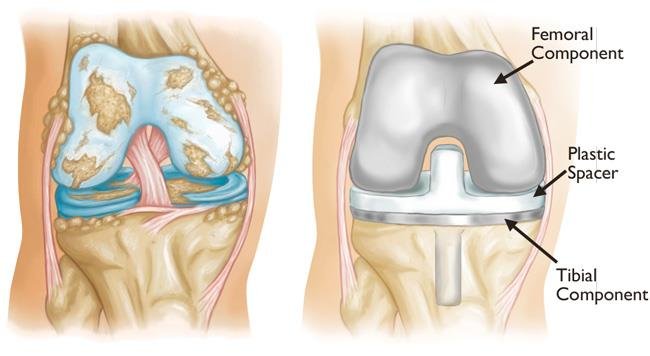Dr Amit Saoji | Orthopedic Surgeon In Nagpur | Orthopedic Doctor in Nagpur
Knee Replacement In Nagpur
Home / Knee Replacement In Nagpur

Total Knee Replacement
Knee replacement surgery was initial performed in 1968. Since then, enhancements in surgical materials and techniques have greatly redoubled its effectiveness.
If your knee is severely broken by inflammatory disease or injury, it’s going to be laborious for you to perform straightforward activities, like walking or ascension stairs. you’ll even begin to feel pain whereas you’re sitting or lying down.
If nonsurgical treatments like medications and exploitation walking supports are not any longer useful, you’ll wish to contemplate total knee replacement surgery. Joint replacement surgery could be a safe and effective procedure to alleviate pain, correct leg deformity, and assist you resume traditional activities.
Anatomy
The knee is that the largest joint within the body and having healthy knees is needed to perform most everyday activities.The knee is created of the lower finish of the femoris (femur), the higher finish of the leg bone (tibia), and therefore the kneecap (patella). The ends of those 3 bones area unit lined with body part gristle, a sleek substance that protects the bones and permits them to maneuver simply inside the joint.
The menisci area unit situated between the thighbone and leg bone. These C-shaped wedges act as “shock absorbers” that cushion the joint.
Large ligaments hold the thighbone and leg bone along and supply stability. The long thigh muscles provide the knee strength.
All remaining surfaces of the knee area unit lined by a skinny lining referred to as the synovium. This membrane releases a fluid that lubricates the gristle, reducing friction to just about zero in a very healthy knee.
Normally, all of those elements add harmony. however sickness or injury will disrupt this harmony, leading to pain, muscle weakness, and reduced operate.
Cause
The most common reason behind chronic knee pain and incapacity is inflammatory disease. though there area unit many varieties of inflammatory disease, most knee pain is caused by simply 3 types: degenerative joint disease, arthritis, and post-traumatic inflammatory disease.
Osteoarthritis. this is often Associate in Nursing age-related “wear and tear” style of inflammatory disease. it always happens in folks fifty years aged and older, however could occur in younger folks, too. The gristle that cushions the bones of the knee softens and wears away. The bones then rub against each other, inflicting knee pain and stiffness.
Rheumatoid inflammatory disease. this is often a sickness during which the synovium that surrounds the joint becomes inflamed and thickened. This chronic inflammation will injury the gristle and eventually cause gristle loss, pain, and stiffness. {rheumatoid inflammatory disease | atrophic arthritis | rheumatism| arthritis | autoimmune disease | autoimmune disorder} is that the most typical sort of a gaggle of disorders termed “inflammatory arthritis.”
Post-traumatic inflammatory disease. this will follow a significant knee injury. Fractures of the bones close the knee or tears of the knee ligaments could injury the body part gristle over time, inflicting knee pain and limiting knee operate.
Description
A knee replacement (also referred to as knee arthroplasty) can be additional accurately termed a knee “resurfacing” as a result of solely the surface of the bones area unit replaced.
There are four basic steps to a knee replacement procedure:
- Prepare the bone : The broken gristle surfaces at the ends of the thighbone and leg bone area unit removed together with a tiny low quantity of underlying bone.
- Position the metal implants : The removed gristle and bone is replaced with metal elements that recreate the surface of the joint. These metal components could also be cemented or “press-fit” into the bone.
- Resurface the patella : The side of the patella (kneecap) is cut and resurfaced with a plastic button. Some surgeons don’t resurface the patella, relying upon the case.
- Insert a spacer : A medical-grade plastic spacer is inserted between the metal elements to make a sleek soaring surface.
The orthopedical analysis
An analysis with Associate in Nursing orthopedical sawbones consists of many components:
- Medical history: Your orthopedical sawbones can gather data regarding your general health and raise you regarding the extent of your knee pain and your ability to operate.
- Physical examination : this can assess knee motion, stability, strength, and overall leg alignment.
- X-rays: These pictures facilitate to see the extent of injury and deformity in your knee.
- Other tests : sometimes blood tests or advanced imaging, like a resonance imaging (MRI) scan, could also be required to see the condition of the bone and soft tissues of your knee.
Your orthopedical sawbones can review the results of your analysis with you and discuss whether or not total knee replacement is that the best technique to alleviate your pain and improve your operate. alternative treatment choices — together with medications, injections, physiotherapy, or alternative styles of surgery — also will be thought of and mentioned.
In addition, your orthopedical sawbones can make a case for the potential risks and complications of total knee replacement, together with those associated with the surgery itself and people which will occur over time once your surgery.
